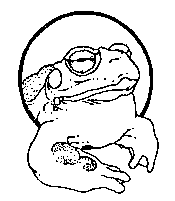 The
Sonoran Desert Toad
The
Sonoran Desert Toad The
Sonoran Desert Toad
The
Sonoran Desert Toad
Bufo alvarius
Los Angeles Times
April 19, 1994
A New Craze Hops Into the Drug Culture
Fads: The quest for new highs has led some seekers to a new low--toad smoking. It's weird, it's illegal, and experts warn that it's probably dangerous, too.
by Leo W. Banks
Some things are so disgusting, it's only a matter of time before they become really popular. So it is with what Arizona police and wildlife officials call the latest fad to sweep the drug culture--toad smoking.
Here's how it's done: You grab a Sonoran Desert toad, an easy task since they don't move very fast, and squeeze the glands near its eyes.
Pretty soon, the glands pop and out oozes a milky substance with the consistency of rubber cement and a chemical makeup similar to LSD. You let this blob dry on glass, cut off a piece, stuff it into a pipe and fire it up.
"A man was arrested for this in California and he described the high," said Don Mattus of the Arizona Fish and Game Department. "He said it's a 20-minute trip so intense that he can hear electrons jumping orbitals in his molecules."
Achieving this mental state is not only illegal but also dangerous--to toad and human--some experts say.
Mattus explained that toad smoking is akin to the even more repulsive toad licking, a popular practice in the '60s that's making a comeback.
"These are things people seem to be experimenting with right now," Mattus said. "They think it's cool because it's gross. What could be more gross than licking a toad?"
Arizona police don't know the extent of the trend, but two recent cases seem to indicate a growing interest.
Last September, a Tucson man was arrested when authorities discovered 62 desert toads in his home. Arizona law forbids the sale of native wildlife, but anyone with a fishing license may legally possess up to 10 desert toads. The man, who claimed the amphibians were pets, was charged with numerous counts of illegally possessing and transporting wildlife.
The other case involved a University of Arizona student arrested after he ran an ad in the student newspaper soliciting desert toads, also called Colorado River toads.
Wildlife experts at first assumed these cases were part of the ongoing trade in which collectors ship exotic desert animals to black-market dealers, usually in Florida, Texas and California. Then the Arizona officials learned of the February arrest of
a California man for possession of
bufotenine, a hallucinogenic chemical secreted by the toads. The man came clean with his intention to smoke the stuff.
Recent publicity surrounding toad smoking has resulted in numerous calls, most originating in California, to Dr. Andrew Weil from people asking how they can get toads.
"I think people are smoking them, but I can't tell you how extensive it is," said Weil, a University of Arizona ethnopharmacologist and drug culture expert.
Still, no toad-smoking arrests have been made here, where bufotenine
is listed as a dangerous drug under state control.
"I don't think law enforcement was even aware this fad was going on until recently," said Lt. Dave Gonzales of the Department of Public Safety. "If a cop in a rural area came upon a man with a bunch of toads, he'd just assume he was collecting toads.
Nobody's going to admit to smoking a toad."
The Sonoran Desert toad is found only in south and south-central Arizona and northern Mexico, and wildlife officials fear that if the trend grows, the region will see an influx of toad hunters.
A good desert toad, which runs up to eight inches long and weighs up to two pounds, yields $8 to $10 on California's drug market, wildlife officials said.
Arizonans usually notice the critters during the summer, when their back yards fill with the rhythmic chorus of toads singing to attract mates and when dogs make the mistake of catching and biting them. The dog may respond with symptoms ranging from excessive salivation and diarrhea to paralysis and respiratory collapse, and may even die.
"The toad possesses a whole package of chemicals to make it distasteful to predators," Lawler said.
Bufotenine is found in all toads, but the Sonoran Desert toad also has
dimethyltryptamine. These two together work as quite a hallucinogenic compound."
The risks to people are considerable.
The problem with getting high off toads, or any organic source, is the wide variation in
dosage, said Jude McNally of the University of Arizona's poison and drug information center. "Even someone who thinks he has experience with it doesn't know what he's getting," McNally said.
Weil said he has smoked toad twice and knows others who have done so hundreds of times, and they came out all right. "It looks relatively safe," he said.
But Lawler believes using it amounts to playing toad roulette. And he fears that the fad might injure the desert toad, which already suffers from an "if it's ugly and it hops, kill it" prejudice.
"I doubt this will catch on in a big way," he said, "but you never know."
Caption:
PHOTO: COLOR, Secretions from the Sonoran Desert toad contain hallucinogenic chemicals.
PHOTOGRAPHER: Arizona Sonora Desert MuseumCopyright, The Times Mirror Company; Los Angeles Times 1994
Record Number: 000036813